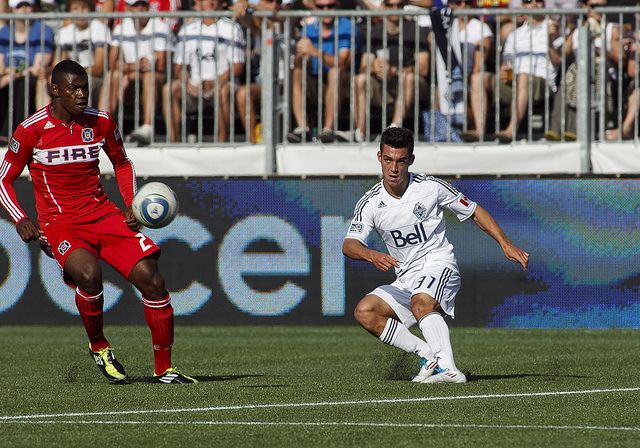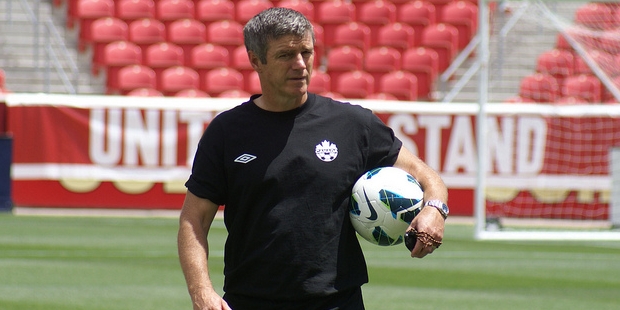
This match on against Chicago a year ago was the last time Teibert–or any other Canadian–has been seen in a Whitecaps uniform on an MLS pitch. Photo courtesy Vancouver Whitecaps FC/flickr
It has been a year since the Vancouver Whitecaps have played a Canadian.
On August 7, 2011, Russell Teibert was subbed on in the 56th minute for Alain Rochat in a 4-2 win over Chicago. Since then, in 38 first team games, not even a single minute has gone to a Canadian international player. This year, the only players, other than the mandatory three Canadians on the Whitecaps roster, that received zero minutes are the third-string goalkeeper and Greg Klazura.
This has been a sensitive subject with Whitecaps fans, who are often sick of hearing about the topic and irascible about the charge that the franchise doesn’t develop Canadians, which, clearly, it does, with strong players at the youth and women’s level and alum on the men’s team. (The argument that Alain Rochat, Canadian-born but capped for the Swiss national team, should count is invalid. If Jacob Lensky signs, that too will be weak. I mean, even Joe Cannon’s eligible for a Canada cap if both sides wanted it. But it’s probably not happening.)
There was a strong connection between the national program and the Whitecaps when the team was in NASL, and it’s mainly gone missing in MLS despite promises that a franchise for the Caps would help transform the program. It’s the elephant in the room. But it’s a little bit more complex than just Canadian teams ought to play Canadians (although that’s not necessarily false), so let’s work through it. I’ll give three reasons why it’s something that’s okay to live with at the moment, and then three why it’s awful.
Why it’s okay
1. They’re trying
The argument for the lack of Canadians from the Whitecaps as a club is perennially that they are working to develop suitable subjects. Pioneering the Residence academy structure has helped, and the strong showing of the club in this year’s USSDA Academy playoffs has proven that there are great prospects like Bryce Alderson and Ben Fisk on their way up. This is a long and painful process, so it’s important not to expect instant results.
2. Can you think of any?
With the exception of any past-or-present Vancouver Whitecaps, which great Canadian players the club can go and get that can make an immediate positive impact in the squad? There are a bunch of sort of okay players bouncing around North America that can’t really make the first-team any more (the Kevin Harmses of the world), the great Canadians in MLS are securely with teams and the ones in Europe are mostly getting better opportunities. Toronto’s experiment with hauling in Julian de Guzman and Dwayne de Rosario ended in tears, so why would it work any better for the Caps?
3. It’s working right now
This is the guiltiest reason of all, of course, but the Whitecaps are playing well right now. There was good squad composition through the beginning of the year, and then after the roster shakeup there is still a great first XI. Nobody else will sympathise with Whitecaps fans on this, especially not Toronto fans that sat through the years starting 2007 when only Canadians counted as domestics. Which brings us to
Why it’s not okay
1. They changed the rules for this
The point of MLS as a league initially was to develop players for the US national team program; the product would be iffy at first, as the demands for players were much larger than the player pool, but it would get better. This is what Toronto was in for. Until the Whitecaps came in to the league, all but 13 of Toronto’s 30 players had to be Canadian. Part of the negotiation necessary to accommodate Vancouver’s club-based academy structure included making US players count as domestics in Canada, and requiring Canadian teams to only carry three truly domestic players.
This wouldn’t be a problem if the Caps weren’t using all three spots on players that haven’t got even a whiff of playing time in the first team. The idea that Caleb Clarke or Bryce Alderson are first-team players (or that Phillipe Davies was) is a farce, because Martin Rennie wouldn’t ever consider putting them on the field. The Whitecaps, in part, helped negotiate the Canadian quota down to a number where they would never have to play them if they don’t want to; and on current evidence, it seems they would rather work with a shorter bench than find players for those spots they would be able to use.
2. Terry Dunfield
I won’t tarry too long here, but it bears saying. Dunfield wasn’t great. But he wasn’t awful, and he was a Canadian, and Tommy Soehn sent him away for nothing. He just beat Julian de Guzman in a competition for places in Toronto. The next time the Whitecaps say they can’t find any good Canadians right now, think of the one they tossed out on a whim.
3. Do they think they’re not good enough?
The Whitecaps first team right now is a lovely cornucopia of nationalities that bends both the mind and the international player rule. There are a lot of great players there! There are a lot of okay players. In substitution situations, they are preferred to Russell Teibert every single time. Andy O’Brian, who is Irish, and Brazilian Tiago Ulisses were just brought in to be okay players. And it seems like the team prefers them not to be Canadian.
This isn’t like, some weird accusation of racism or something! The fact is that what you battle in the growth of a program is stereotypes and prejudice. Players like Paul Pechisolido and Paul Stalteri were evidence that Canadians could do well in England. Canadians need to prove they can earn their keep in a top flight. When the Whitecaps say “we want Canadians, we just want to develop them ourselves”, that might translate to an opinion that Canada has not produced any MLS players worth getting, and we have to make them ourselves to trust them. That’s the problem.
There are clubs where the coaching staff believe that Canadians aren’t up to snuff and can’t compete, and the battle is convincing them that they are wrong. It’s just bitter that the Whitecaps are one of those clubs.
Continue reading →

